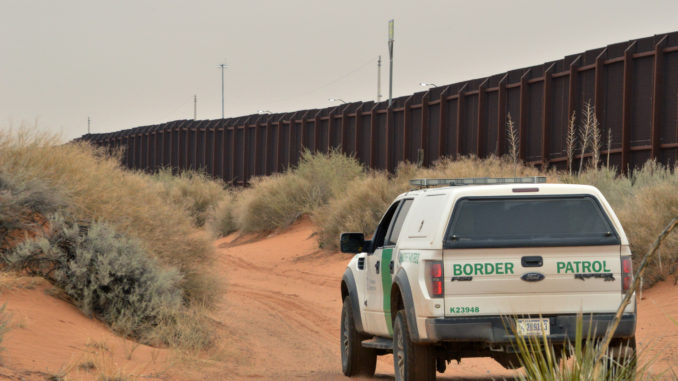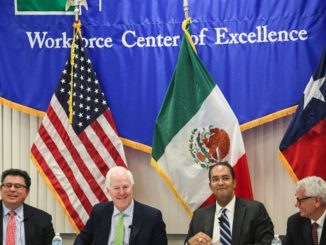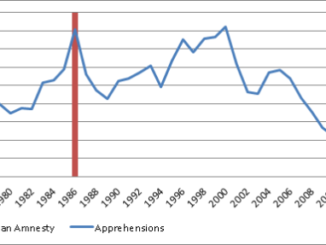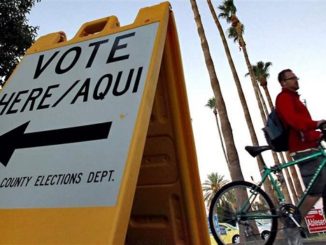
by Roger F. Noriega, Jose R. Cardenas / American Enterprise Institute
Key Points
- The recent influx of illegal Central American immigrants (including a surge of unaccompanied minors) into the United States stems in part from violent, sophisticated drug trafficking operations in those nations and governments that are either unwilling or unprepared to confront organized crime. These operations are not only driving many more immigrants to the United States but also threatening US national security.
- Investing additional money in fences and border patrol agents alone will not solve US illegal immigration problems. Short-term steps for the US should include thwarting human smuggling, addressing human rights and refugee concerns before people abandon their countries, and mobilizing international cooperation and funding.
- To address immigration and security problems in the long term, a US-led multinational initiative is needed to better equip Central American governments to confront criminal organizations and drug trafficking and to hold corrupt officials accountable.
President Obama has requested $3.7 billion in emergency funding to cope with the influx of illegal immigrants along the US southern border, which has been inundated by a surge in unaccompanied minors and thousands more trying to enter the United States from Central America through Mexico. Notwithstanding that considerable sum of money requested from Congress, it is clear that the programs currently being implemented and planned by the administration are primarily stopgap measures-dealing with border security, detention conditions, and deportations. They do nothing to address the primary driver of the problem: the escalating criminality and corruption in Central America-most of it fueled by illegal drug trafficking to the United States-that are undermining democratic institutions, rule of law, economic opportunity, and public safety.
To gain control of, and ultimately secure the US southern border, the administration must focus its attention on helping our partners in Central America do a better job in ensuring the security of their own citizens. Only by suppressing the “push factor”-what is compelling people to abandon their countries for safety in the United States-can the flow northward of Central American immigrants be stemmed.
The US must lead a multinational security initiative that provides resources, training, and institution building and that rallies regional resolve to confront the criminal networks. Without a substantial effort on the front lines in Central America, more fencing and border patrol agents will fail to meet the critical objective of securing the US southern border.
Neighbors in Trouble
The criminal threat that Central America is confronting today is every bit as dangerous to its peace and security as the Soviet- and Cuba-sponsored subversion of the 1970s and 1980s. The region is now considered the most violent nonwar zone in the world.
According to the United Nations Office on Drugs and Crime, Central America has a rate more than four timesthe global average homicide rate, making it a subregion with one of the highest homicide rates on record.[1] Reported incidents of robberies, extortion, kidnappings, and human trafficking are all up in recent years. As a result, poll after poll invariably finds the greatest concern among the people of the region is personal security.[2]
Immediate Steps to Stop the Surge at the Southern BorderThe current crisis on the US southern border represents a long-term security challenge for the United States and Central America. However, it is imperative from a humanitarian standpoint to move quickly and decisively to secure the border by bringing the surge of illegal immigration under control. The executive branch and Congress must work cooperatively on the following actions:Block Human Smuggling Now. Exercise presidential authorities under the Illegal Immigration Reform and Immigrant Responsibility Act of 1996 to allow US border patrol and immigration officers at the scene to use their legal discretion to assess asylum claims to facilitate the urgent return of most illegal immigrants. Arranging the immediate voluntary return in most cases is essential because
Address Human Rights and Refugee Concerns. Ensure due process for minors and others with legitimate refugee or asylum claims by
Mobilize International Cooperation and Funding. Convene an international summit with representatives of Central America, Mexico, the Inter-American Development Bank, the United Nations, the United States, and other international development agencies to
|
The increased crime and violence has also exacted a heavy economic cost. A UN Development Program report puts the financial costs of violence at a 2.5 percent loss of gross domestic product in Costa Rica, with a loss of more than 10 percent in Honduras.[3] With the International Monetary Fund projecting overall Latin American economic growth at only 3 percent this year, the loss of domestic and foreign investment because of security concerns will have a drastic impact.[4] Productivity will be further hurt by the number of citizens who continue to seek refuge in other countries, principally the United States.
Most of the violence can be attributed to the drug trade. The region has found itself literally caught between two larger countries-Mexico and Colombia-that have conducted their own major crackdowns on transnational criminal organizations, forcing the latter to find more permissive environments to ply their nefarious trades. The State Department’s latest International Narcotics Control Strategy Report estimates that approximately 86 percentof the cocaine trafficked to the United States in the first half of 2013 first transited the Mexico-Central America corridor.[5] The three countries most responsible for the surge of immigrants attempting to enter the United States-El Salvador, Honduras, and Guatemala-are all designated as major transit countries.
In El Salvador, criminal networks and gangs provide protection for drug shipments, weapons, and human trafficking transiting the country. In Honduras, which has one of the highest homicide rates in the world, an estimated 75 percent of all cocaine-smuggling flights departing South America first land in its territory. In Guatemala, as much as 80 percent of the drugs bound for the US market transit through the country, while Mexican cartels control as much as 40 percent of its territory.[6]
Local governments, plagued by weak institutions and poorly trained law enforcement, have proven no match for these well-financed international criminal organizations, which are aided and abetted by local gangs. As a result of the insecurity and resulting drop in economic opportunity, the number of Hondurans, Guatemalans, and Salvadorans attempting to cross the US southern border increased 60 percent last year, and that number will surely be exceeded this year.
Evolving and Expanding Criminal Networks
The world of transnational crime has evolved markedly since the days of the Medellín and Cali Cartels. Today’s transnational criminal organizations (TCOs) are more sophisticated, lean, opportunistic, and diversified. In Central America, their presence also happens to be leavened with a healthy dose of gang activity. The unprecedented expansion of these criminal networks and violent gangs in the Americas is corroding the integrity of democratic institutions and the stability of several of our partner nations. TCOs threaten citizens’ security, undermine basic human rights, cripple rule of law through corruption, erode good governance, and hinder economic development.
As General John Kelly, commander of the US Southern Command, put it in recent testimony before Congress, “Picture an interconnected system of arteries that traverse the entire Western Hemisphere, stretching across the Atlantic and Pacific, through the Caribbean, and up and down North, South, and Central America. Complex, sophisticated networks use this vast system of illicit pathways to move tons of drugs, thousands of people, and countless weapons into and out of the United States, Europe, and Africa with an efficiency, payload, and gross profit any global transportation company would envy.”[7]
“In return,” he went on, “billions of dollars flood back into the hands of these criminal enterprises, enabling the purchase of military-grade weapons, ammunition, and state-of-the- art technology to counter law enforcement. This profit also allows these groups to buy the support or silence of local communities through which these arteries flourish, spreading corruption and fear and undermining support for legitimate governments.
Gen. Kelly added, “These networks conduct assassinations, executions, and massacres, and with their enormous revenues and advanced weaponry, they can outspend and outgun many governments. Some groups have similar and in some cases, superior training to regional law enforcement units. Through intimidation and sheer force, these criminal organizations virtually control some areas.”
Indeed, awash in cash, these criminal organizations can intimidate, eliminate, or coopt anyone and everyone they come in contact with in pursuing their illicit activity-including border agents, judges, police officers, the military, politicians, and government officials.
International Criminals and Local Gangsters
In past years, Central America served as largely a refueling stop for traffickers moving cocaine northward. But while US counternarcotics efforts have largely impeded trafficking routes elsewhere, TCOs began seeking more hospitable environments, and that has meant exploiting more aggressively land routes through the Central American isthmus. In turn, these new paths impinged on areas controlled by local organized crime groups, upsetting the balance of power among them.
While these groups had long been involved in cross-border trafficking, the surge in cocaine trafficking has raised the stakes, promoting competition for territorial control. All of this has translated into a perfect storm of criminal convergence in a region already challenged by weak institutions. The looser, more flexible criminal groups are more able to suborn public officials or discreetly launder money. Law enforcement also has more difficulty rolling up entire operations, since they are smaller and less unified than the old cartels.
Another new complication is that regional governments are demonstrating either complicity with the traffickers and criminals or a simple lack of interest in cooperating with the United States, especially on counterdrug efforts. Obviously, these attitudes have hampered efforts to develop a comprehensive, multilateral response to push back on criminal groups.
The new arrangements have allowed Central American gangsters to tap into a broader international criminal network. The focal point of this transnational criminal conspiracy remains Colombia’s Fuerzas Armadas Revolucionarias de Colombia (FARC). According to former Washington Post investigative journalist Douglas Farah, “FARC, despite engaging in ongoing peace talks with the government of President Juan Manuel Santos, remains at the center of a multitude of criminal enterprises and terrorist activities that stretch from Colombia south to Argentina, and northward to Central America and into direct ties to the Mexican drug cartels, primarily the Sinaloa organization.”[8] He calls it a “pioneer hybrid criminal-terrorist insurgency, using drug money to sustain an ideological movement.” However, over time, the group’s ideological fervor has been supplanted as it has become much more of a business enterprise, helping to enrich its leadership and the leadership of the regional governments it supports. (It is estimated that FARC garners between $500 and $600 million annually from its illicit activities.[9])
In Venezuela, late leader Hugo Chávez made no effort to disguise his affinity for FARC or his disdain for US security policies. Even after his death, the drug flights continue through Venezuelan territory, and six Venezuelan military officials remain designated as “drug kingpins” by the Treasury Department.[10] (See figure 1.)
It is also a fact that the populists of the Chavez ilk, including Rafael Correa in Ecuador and Evo Morales in Bolivia, have rejected security cooperation with the United States, expelling the Drug Enforcement Administration and other counternarcotics personnel and further undermining the ability of the United States to deter criminal activities and prevent illicit narcotics from making their way north.
A disturbing insight into the criminal-political conspiracy can be found in the information that Colombian authorities seized from the computers of FARC’s Raul Reyes after a bombing raid on his camp in 2008.[11] The data provided a startling account of the extent to which FARC has attempted to buy the complicity of regional governments through campaign contributions and other methods. In particular, FARC’s reach into Central America-a region infinitely more vulnerable than the larger countries to the south-is alarming.
El Salvador has recently inaugurated leftist ex-guerrilla Salvador Sánchez Cerén as its president. Sánchez Cerén has a long history of solidarity and support for FARC. In addition, José Luis Merino, another former guerrilla whose criminal activities were exposed in the Reyes computers, is known as FARC’s man in El Salvador; he plays a central role in the Frente Farabundo Martí para la Liberación Nacional (FMLN) shadow government managing the flow of Venezuelan assistance to the FMLN through Alba Petróleos.[12]
The explosion of drug trafficking through Honduras occurred during the presidency of Manuel Zelaya, whose links to drug trafficking are well-established.[13] When Zelaya maneuvered to amend the country’s constitution so he could seek reelection, he was removed from office. Hugo Chávez rallied left-wing governments to demand Zelaya’s return. The Obama administration joined that ill-conceived effort, even suspending US antidrug aid and making the country more vulnerable to drug cartels. Although Zelaya never returned to power-and his wife failed in her bid for the presidency in 2013-his continued political activism from his position in the Honduran congress undermines the country’s ability to resist criminality. Instability serves the interests of Zelaya and his criminal associates.
Of course, the threats to regional instability are not solely ideological; however, divergent political agendas undermine international cooperation. Clearly, the primary motivation is money. Moreover, the problem extends beyond FARC to include other TCOs: the Mexican cartels, Hezbollah, Chinese gangs, the Russian and Italian mafias, to name just a few. All stand to gain from continued instability in Central America.
Strengthening Democracy, Rule of Law, and Citizen Security
In addition to the great harm done to the physical well-being and security of citizens, organized-crime activities are increasingly crossing the line into politics and governance. TCO and gang activity undermine democracy by replacing functions of the state and wielding more control over civilian life, especially in areas where central government presence and oversight are limited. Such dangerous trends constitute the most profound threat to the integrity and effectiveness of Central American democracy today.
Some argue that what is needed is a major “rethink” of international drug policies. But decriminalization or legalization of drugs is not the answer. This line of thinking misses the fundamental point that declining security and stability in Central America results primarily from the lack of strong institutions to provide for public security. Local governments need better-trained and better-equipped police forces, but they also need to tackle the twin threats of corruption and impunity.
In the long term, cutting crime and violence and strengthening the rule of law in Central America will require reform and institution building-in the criminal justice system, police forces, and prisons. Only with a long-term program of state capacity building and development will the TCOs be brought under control so that democratically elected authorities can serve the people effectively. The imperative is establishing order, and that means reducing the capacity and opportunities for criminals to challenge and subvert the state. This involves several actions:
- Improving the effectiveness of criminal justice procedures and practices by rooting out corrupt judges and turning around the extremely low conviction rates through more efficient and independent courts.[14]
- Developing the capacity to dismantle the financial networks of criminal organizations by developing effective asset-forfeiture laws and exposing money laundering and also enforcing new campaign finance laws to break up political-criminal conspiracies.
- Improving penal systems, specifically prisons. Establishing prisons to deter crime and rehabilitate inmates, rather than having them being used to perpetuate and, in some cases, increase criminal activity from virtual safe havens.
- Promoting the use of extraditions as a deterrent for crime and a means to reinforce national security.
A US-Led International Rescue Effort
To date, the signature United States program in response to the rising violence is the Central America Regional Security Initiative (CARSI). CARSI takes a comprehensive approach to promoting security, including providing equipment, training, and technical assistance to support immediate law enforcement and interdiction operations, as well as strengthening government institutions. Since FY 2008, Congress has appropriated an estimated $803.6 million for Central America through Mérida/CARSI-and the administration has requested an additional $130 million for CARSI in FY 2015. Also, the Central American Citizen Security Partnership encompasses all US federal efforts to help combat drug trafficking, gangs, and organized crime. A Group of Friends of Central America donors team works with Central American governments and the Central American Integration System to implement a Central American Security Strategy.[15]
Still, if the current US border humanitarian crisis is any indication, these policies to mitigate the push factor have to date proven to be insufficient. What is needed at this point is a fundamental overhaul of the administration’s approach to Central American security. The problem is not that US agencies are doing something wrong in the region; it is that they are not doing enough. Therefore, more resources are required to expand the effort and to press regional governments to commit to necessary and difficult reforms. Combating violence and transnational crime requires nationwide sacrifice and a multidimensional strategy-and engagement at the international level.
Authorities in Guatemala and Honduras appear to be overwhelmed by the criminals who use vast resources and violence to impose their criminal behavior. The national security services (both armed forces and police) are too small, underfunded, poorly equipped, and unprepared to enforce the law against powerful smugglers and deadly gang leaders. An emergency response could include the deployment of a new UN mission with the mandate to recruit, train, mentor, equip, and shore up local police forces; a UN force could also facilitate cross-border operations against transnational criminal activities.
Such a groundbreaking initiative is only possible in the context of a US-led multinational initiative bringing together regional government officials; affected countries and regions such as Colombia, Mexico, and the European Union; and multilateral institutions such as the Organization of American States and the Inter-American Development Bank. The objectives would be to combat crime and promote rule of law and citizen security, while also developing targeted aid programs to jump-start economic growth and create jobs.
There is also a dire need for a more effective public diplomacy campaign. We must make clear-in our diplomacy, aid programs, and messaging-that the failure to uphold the rule of law threatens a country’s sovereignty, institutions, youth, and political and economic future.
The administration also should name and shame governments that have willfully shunned cooperation with the United States on security and counternarcotics policies to score cheap political points at home, specifically Venezuela, Ecuador, and Bolivia. These uncooperative nations must be held accountable for the damage they do to the political stability and economic productivity of the hemisphere.
The US must be engaged in this process at a high level-through providing resources and transferring experiences, based on past successes and failures. By now, no one should be under the misperception that Central America’s problems are not US problems too. Those same criminal networks can move just about anything through their smuggling pipelines, which lead directly to our borders and can be exploited by anyone looking to do the US harm. This crime-terror convergence is a very real vulnerability the nation cannot afford to ignore. All it takes is one corrupt official who can be bribed to procure official documents such as visas or citizenship papers and facilitate travel of aliens who may wish to harm the United States.
Moreover, US security already is being affected by these criminal networks. International drug traffickers have a presence in up to 1,200 American cities, as well as criminal enterprises like the violent transnational gang Mara Salvatrucha (MS-13) that specialize in extortion and human trafficking.
It is very clear that drug traffickers, criminal networks, and others who pose a threat to US security are filling the vacuum left by waning American leadership. That is why high-profile US engagement with Central America is essential to address the root causes of the dramatic humanitarian crisis on the US southern border.
José R. Cárdenas ([email protected]) held senior posts in the administration of George W. Bush and is a director of Vision Americas LLC, a consulting firm that represents US and foreign clients. Roger F. Noriega ([email protected]), a former senior US Department of State official, is a visiting fellow at AEI and managing director of Vision Americas LLC.
Notes
1. Corey Kane, “Honduras, Central America Still Lead the World in Murder Rates,” Tico Times, April 14, 2014, www.ticotimes.net/2014/04/14/honduras-central-america-still-lead-the-world-in-murder-rates.
2. “A Broken System,” Economist, July 12, 2014, www.economist.com/news/americas/21606864-citizens-security-regions-biggest-problem-time-improve-criminal-justice-broken.
3. United Nations Development Program, Regional Human Development Report 2013–2014, Citizen Security with a Human Face: Evidence and Proposals for Latin America, November 2013, www.undp.org/content/dam/rblac/docs/Research%20and%20Publications/IDH/IDH-AL-ExecutiveSummary.pdf.
4. Kieran Lonergan, “IMF Lowers Latin America Growth Forecast Despite Improved Global Outlook,” BN Americas, January 22, 2014, www.bnamericas.com/news/banking/imf-lowers-latin-america-growth-forecast-despite-improved-global-outlook.
5. United States State Department, Bureau for International Narcotics and Law Enforcement Affairs, International Narcotics Control Strategy Report, Volume 1: “Drug and Chemical Control,” March 2014, www.state.gov/documents/organization/222881.pdf.
6. Ibid.
7. “Posture Statement of General John F. Kelly, United States Marine Corps Commander, United States Southern Command,” testimony before the 113th Congress Senate Armed Services Committee, March 19, 2013, www.southcom.mil/newsroom/documents/southcom%202013%20posture%20statement%20final%20sasc.pdf.
8. Douglas Farah, “Terrorist Groups in Latin America: The Changing Landscape,” testimony before the House Foreign Affairs Subcommittee on Terrorism, Nonproliferation, and Trade, February 2014, http://docs.house.gov/meetings/FA/FA18/20140204/101702/HHRG-113-FA18-Wstate-FarahD-20140204.pdf.
9. Stephanie Hanson, FARC, ELN: Colombia’s Left-Wing Guerrillas, Council on Foreign Relations, August 19, 2009, www.cfr.org/colombia/farc-eln-colombias-left-wing-guerrillas/p9272.
10. Ramón Rodriguez Chacin, Hugo Armando Carvajal Barrios, and Henry de Jesús Rangel Silva were among the names designated by the Treasury Department on September 9, 2008 (see www.treasury.gov/press-center/press-releases/Pages/hp1132.aspx); on September 8, 2011, Amilcar Jesús Figueroa Salazar, Cliver Antonio Alcalá Cordones, Freddy Alirio Bernal Rosales, and Ramón Isidro Madriz Moreno were also designated for providing arms and security to FARC (see www.treasury.gov/press-center/press-releases/Pages/tg1295.aspx).
11. Hannah Stone, “Timeline: Revelations from the ‘Raul Reyes’ Computers,” InSight Crime, April 26, 2011, www.insightcrime.org/news-analysis/timeline-revelations-from-the-raul-reyes-computers.
12. José Luis Merino, a Marxist guerilla commander turned into a politician, has been responsible for managing ALBA Petroleos in El Salvador and laundering money from the company to fund guerillas and narcotrafficking in that country.
13. Roger F. Noriega and José Javier Lanza, “Honduras under Siege,” AEI Latin American Outlook, September 30, 2013, www.aei.org/outlook/foreign-and-defense-policy/regional/latin-america/honduras-under-siege/.
14. Peter J. Meyer and Claire Ribando Seelke, Central America Regional Security Initiative: Background and Policy Issues for Congress, Congressional Research Service, May 6, 2014, http://fas.org/sgp/crs/row/R41731.pdf.
15. For more information see Clare Ribando Seelke, Gangs in Central America, Congressional Research Service, February 20, 2014, http://fas.org/sgp/crs/row/RL34112.pdf



